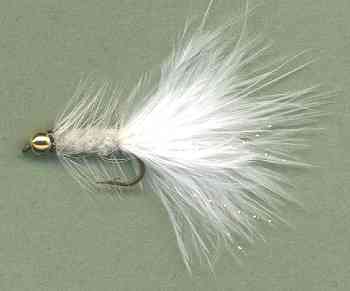The Beaded White Woolly Bugger Fly
The Woolly Bugger fishing fly pattern has to be one of the most versatile and productive flies around. The marabou tail and in most cases a palmered body suggest succulent small juvenile bait fish, insect larva, tadpoles or leeches that trout, bass and steelhead devour

WOOLLY BUGGER STREAMER FLY PATTERN. Hook size 10 4 2 - $US each
WOOLLY BUGGER STREAMERS
Drag a Woolly Bugger across the current in front of some trout and this fly becomes a killer. We have added additional flash to improve there performance. From experience it helps catch the eye of a predatory trout or salmon when the flash in the tail reflects a quick glint of sunlight as the marabou tail moves through the water. It is a great modern streamer pattern and appears in many colors and hook sizes. You can use it for bass, trout or panfish as well. It's a great fly, and every flybox should contain several. You fish it like a streamer. This fly's colorful name and the gnarly way it looks can be deceiving. This is a big fish fly, perhaps the very best big fish fly in use currently. The Woolly Bugger has a lively marabou feather tail that "breathes" in the water and looks lively to hungry trout. Dressing a fly by winding the hackle the length of the body is mentioned in fly fishing books of the fifteenth century. It is called the palmer style of dressing. About the time Napoleon was fighting the British in France and Spain, palmer flies were being praised in books as the first fly to be used until a hatch was observed. The palmered hackle helps suggest to the trout that the fly is alive by its movement.
A Harrisburg, Pennsylvania fly tier, Russell Blessing tied the first "Buggers". He added a marabou tail to a woolly worm fly, to help suggest a swimming movement as the fly was retrieved in the water. He found that even if fished dead-drift the fly still had movement. The woolly worm is a very old fly that can be found in Izaak Walton's 1653 book "The Compleat Angler". Russell's original Woolly Bugger had a black marabou tail, and a black hackled olive chenille body, (just like our Viva Woolly Bugger). He had designed it to fish the small mouth bass in the streams near his home. He had been trying to imitate the dobsonfly lava. Back in 1967 on a hot August afternoon flyfishing journalist Barry Beck was having a hard time getting the fish to bite on the Little Lehigh River in Pennsylvania, USA. Other flyfishermen nearby were also having the same problem, that is all except one, Russ Blessing. In a 30 minute period he netted four nice trout. Barry went over and asked what fly he was using. Barry was shocked to find it was a streamer. This type of fly normally was not very productive on the Lehigh River and especially in August. Russ, a true gentleman fly fisherman who was always willing to share his knowledge of fly-fishing and fly-tying gave Barry one of his Woolly Buggers to try. Barry's luck changed and he started to catch trout. Barry was so impressed that when he met Russ in the parking area just as he was going home he asked for more information about the fly.

This is fly fisherman Russell Blessing, the designer of the original Woolly Bugger Fly Pattern
Barry published an article on Russell Blessing's wondrous Woolly Bugger in 1984. The rest is history. It became so popular that it is now an American standby. Woolly Buggers catch trout, bass, and salmon in both Atlantic and Pacific rivers, steelhead, Arctic char, northern pike, bluegills and even carp. It would not be an exaggeration to say that there is hardly a fish that swims that could not be caught with a Woolly Bugger. This wide-ranging success is due to the fact that these flies can be used to imitate a variety of fish food forms, including baitfish, crustaceans, insect nymphs salamanders and leeches. To achieve this chameleon status, Woolly Buggers are tied in green, red, olive, gray, grizzly, brown, black, yellow, white, and purple and in all combinations of these colors. This fly can be fished near the surface, or with the addition of weight it is often fished deep. Obviously the Woolly Bugger may not be a glamorous fly, but it deserves to be in everyone's fly box for all kinds of fly fishing, from warmwater to saltwater. Russ Blessing retired in 1996 and when asked what he now did with all his spare time he replied, "I fish".
The Woolly Bugger is a very versatile fly to fish. You can cast it upstream and fish it like a nymph, or cast across a stream and let it drift with the current. A great way to fish streamer flies is to cast across stream, let the current carry it down and across and make stripping retrieves, pulling 6-24" in your fly line, imparting subtle and deliberate action to the fly. The hackle will twitch back over the body and the tail will flare and wiggle supply. This drives fish wild and brings surprising hook ups and many big fish! The word "bugger" is rude in England and described the sex act between to men. Most older traditional English fly tying books do not acknowledge the Woolly Bugger by name, but instead they used to call it wrongly the Woolly Worm or tadpole fly. Modern books now give it it's proper name. In the mid 1980's a fly very similar to the Woolly Bugger became popular in the UK. It was called the Dog Nobbler and was designed and promoted by Trevor Housby. It looks exactly like a woolly bugger except that it had a weighted head.
Fishing the Woolly Bugger is a matter of patience and confidence. Because of the soft saddle hackle rib and the marabou tail, it does not require much action on the part of the angler to give this fly a pulsating, undulating look. In a stream or river, slow to very slow is the key because the current will make it look alive. In a lake, a little more action may be required, but not too much and not too fast. Remember that our Woolly Bugger flies are more superior as they have additional 'flash' added to their tails to get them noticed by predatory trout and salmon.
One of my favorite use of a woolly bugger is for the sport of trying to coax trout that lurk in deep plunge pools to rise up to the surface and take my presentation. They normally will not do so for a dry fly. It has to be a more substantial meal to be worth the effort. I try to imitate a small fish that has been temporally stunned as it swam over the waterfall and landed in the plunge pool. Cast your fly as near to the waterfall as you can. Give it a few moments to sink and then begin the retrieve to imitate the fish recovering and quickly swimming away from it's vulnerable static location to safety. Using the same idea look for deep slow pools near where a stream is forced to drop suddenly due to a narrow rock channel. Small fish will be forced down with the strength of the current before they can quickly swim off to the relative safety of the bank. Drop your streamer into this current and let it sink. Then start you retrieve. Trout can be teased into chasing your fly.
LINKEDIN COMMENT
What flies work best for Cutthroat Trout? - For SRC flies in Puget Sound, I am a big fan of Bob Triggs' Chum Baby, the Keta Rose (which imitates pink salmon fry quite well), rolled muddlers as mentioned, small clousers and wooly buggers (in white and olive), and sand-lance patterns. Scuds will work too, and if you're looking for an adrenaline rush, topwater gurglers, poppers and sliders will all draw strikes, though your hookup rate might drop a bit. These fish are a blast in the salt and live in some of the most beautiful areas in the Northwest; anyone who has the good fortune to fish for them is in for a treat. - By Peter Laegreid

